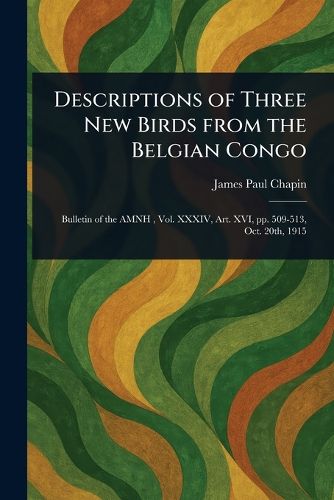Readings Newsletter
Become a Readings Member to make your shopping experience even easier.
Sign in or sign up for free!
You’re not far away from qualifying for FREE standard shipping within Australia
You’ve qualified for FREE standard shipping within Australia
The cart is loading…






This title is printed to order. This book may have been self-published. If so, we cannot guarantee the quality of the content. In the main most books will have gone through the editing process however some may not. We therefore suggest that you be aware of this before ordering this book. If in doubt check either the author or publisher’s details as we are unable to accept any returns unless they are faulty. Please contact us if you have any questions.
Delve into the heart of early 20th-century ornithology with James Chapin's "Descriptions of Three New Birds from the Belgian Congo." This meticulously prepared print edition offers a fascinating glimpse into the avian wonders of the Ituri Forest. Originally published in 1915 as part of the "Bulletin of the AMNH," this work presents detailed descriptions of newly discovered bird species from a region then known as the Belgian Congo.
A valuable resource for anyone interested in the history of zoology, ornithology, or the natural history of Central Africa, this book provides primary-source insights into the classification of birds in a remote and ecologically rich environment. Explore the meticulous observations and documentation that contributed to our understanding of the world's biodiversity, captured during a pivotal era of scientific exploration. Discover the enduring legacy of Chapin's work as it continues to inform and inspire naturalists and researchers today.
This work has been selected by scholars as being culturally important, and is part of the knowledge base of civilization as we know it.
This work is in the public domain in the United States of America, and possibly other nations. Within the United States, you may freely copy and distribute this work, as no entity (individual or corporate) has a copyright on the body of the work.
Scholars believe, and we concur, that this work is important enough to be preserved, reproduced, and made generally available to the public. We appreciate your support of the preservation process, and thank you for being an important part of keeping this knowledge alive and relevant.
$9.00 standard shipping within Australia
FREE standard shipping within Australia for orders over $100.00
Express & International shipping calculated at checkout
This title is printed to order. This book may have been self-published. If so, we cannot guarantee the quality of the content. In the main most books will have gone through the editing process however some may not. We therefore suggest that you be aware of this before ordering this book. If in doubt check either the author or publisher’s details as we are unable to accept any returns unless they are faulty. Please contact us if you have any questions.
Delve into the heart of early 20th-century ornithology with James Chapin's "Descriptions of Three New Birds from the Belgian Congo." This meticulously prepared print edition offers a fascinating glimpse into the avian wonders of the Ituri Forest. Originally published in 1915 as part of the "Bulletin of the AMNH," this work presents detailed descriptions of newly discovered bird species from a region then known as the Belgian Congo.
A valuable resource for anyone interested in the history of zoology, ornithology, or the natural history of Central Africa, this book provides primary-source insights into the classification of birds in a remote and ecologically rich environment. Explore the meticulous observations and documentation that contributed to our understanding of the world's biodiversity, captured during a pivotal era of scientific exploration. Discover the enduring legacy of Chapin's work as it continues to inform and inspire naturalists and researchers today.
This work has been selected by scholars as being culturally important, and is part of the knowledge base of civilization as we know it.
This work is in the public domain in the United States of America, and possibly other nations. Within the United States, you may freely copy and distribute this work, as no entity (individual or corporate) has a copyright on the body of the work.
Scholars believe, and we concur, that this work is important enough to be preserved, reproduced, and made generally available to the public. We appreciate your support of the preservation process, and thank you for being an important part of keeping this knowledge alive and relevant.